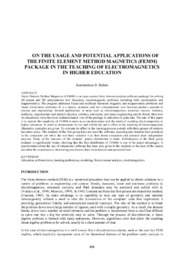On the usage and potential applications of The finite element method magnetics (femm) Package in the teaching of electromagnetics In higher education
Abstract
Finite Element Method Magnetics (FEMM) is an open source finite element analysis software package for solving
2D planar and 3D axisymmetric low frequency electromagnetic problems including both electrostatics and
magnetostatics. The program addresses linear and nonlinear harmonic magnetic and magnetostatic problems and
linear electrostatic problems. It is a simple, accurate, and low computational cost freeware product, popular in
science and engineering. Several applications in areas such as electromagnetics, materials science, industry,
medicine, experimental and particle physics, robotics, astronomy and space engineering can be found. However
its educational value has been underestimated. Use of the package in education is quite rare. The aim of this paper
is to explore the capability of FEMM to meet as a complementary tool the needs of teaching electromagnetics in
higher education. In order to demonstrate its use and exhibit the aid it offers in the teaching of electromagnetics
illustrative examples are given. To evaluate its effect in the learning process a study with three groups of students
has taken place. The students of the first group have not used the software; second group students have practiced
in the computers lab while the rest have installed it in their home computers and pursued short independent
projects. Study of the statistics of the students’ grades distribution is made. Performance of the third group
students is significantly better, showing that the free distribution of FEMM is one of its major advantages. A
questionnaire about the use of educational software has been also given in the students in the start of the course
and after the examinations. Interesting conclusions have been derived and presented here.
